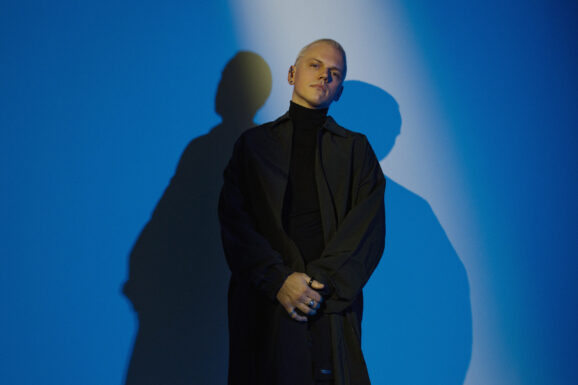Color of Noize is only Derrick Hodge’s third album under his own name but he has been almost ubiquitous in recent years as a sidemen, producer, collaborator and opinion leader. The composer/bassist/bandleader has collaborated with Robert Glasper, Maxwell, Terence Blanchard, and Common. He’s played on Grammy-winning albums by all four. He’s produced for Blue Note label mates Kenrick Scott and James Francies, he’s worked with Quincy Jones, he’s brought new thinking to major orchestras and to the Monterey 2019 Jazz Festival as its artist-in-residence. He is the co-founder, along with Glasper for the supergroup R+R=Now. And, he’s been involved in plenty others, film scores included. So, this new project – the band and album name, Color of Noize brings high anticipation.
That anticipation revolves around how Hodge will mesh his various influences. We’re heard much of what is referenced above and know that it will be a mix of jazz, contemporary R&B, hip-hop groove, along with deep moments of soul and spirituality. The anticipation is, put simply – just how will he pull these disparate elements together coherently as well as the dynamics of and personalities involved in this new band. Hodge makes it sound a little simpler, “It’s the contrast, it’s the beauty, it’s the chaos, it’s the freedom – of that.” Yet, there are several new things taking place here – it’s the first time he’s used a live band throughout a record, it was the band’s first time playing together, their first time hearing the songs Hodge brought to the session, and first time Hodge used a co-producer – fellow bassist and Blue Note president Don Was. The album was mostly recorded in just two days.
So, first the Color of Noize band is Jahari Stampley (piano, organ), Michael Asberg (keyboards, synths), Mike Michell and Justin Tyson on drums, and DJ Jahi Sundance on turntables as Hodge supplies bass, keys, guitar, and voice. Says Was, “It was powerful to see this group of young, brilliant improvisers set up in a circle at Hollywood’s historic United Studio A. It felt like a throwback to what it might have been like on the floor of a Blue Note session at Rudy Van Gelder’s studio in the mid-sixties. These were ‘old school’ sessions yielding modern music so forward-looking and visionary that there is no existing genre within which to categorize it.” That statement is so powerful that it’s tempting to just end this review right here but perhaps it’s just piqued curiosity more.
To realize that these musicians were seeing the music for the first time and much of it went down spontaneously in one take is remarkable. If you sample the title track first, “Color of Noize,” the song, is a shimmering, skittering meandering journey with slowly shifting tones stretching across a flurry of constantly exploding percussion. “You can hear the drummers going for blood,” says Hodge. “I just wanted everyone to trust their own artistry. They did.”
Aside from Hodge, the shining star is Stampley, who was to some extent a gamble. The 18-year-old was tapped based on a single short YouTube clip Glasper sent Hodge. This was his first studio recording ever — proof that, as Hodge says, “We’re putting something on the line here.” Not only does spontaneity and improvisation abound but it’s clear these musicians are intently listening each other to create these blends of sound that defy a live session. Opener “The Cost” starts calmly before exploding into flurries of piano notes “Not Right Now” finds funk groove and classical overtones merging. “You Could Have Stayed” is a dreamy with its bowed bass and humming organ. The lone cover, Wayne Shorter’s “Fall” finds the band swinging hardest sandwiched between the echoes of Flying Lotus’ rich electronica in “19”, the lonesome digitized folk of Bon Iver in “Looking at You,” the latter featuring just Hodge on vocals and piano with Mitchell on drums.
The foundation of “Looking at You” is a piece Hodge recorded via phone at home, sitting at the 1902 Ludwig upright where these songs began. “I wanted people to feel like they’re in the room with me, imagining,” he says. That piano also appears on “Little Tone Poem” along with his family, continuing a Hodge tradition of working raw snippets of his life into his albums despite how different each one has been, from 2013’s guest-packed Live Today to 2016’s almost entirely solo The Second to this live band set.
Hodge is involved in so many diverse musical and film projects that many might associate him with the new breed of L.A. musicians but Hodge hails from Philadelphia with his degree from Temple University’s
Boyer College of Music. Hodge sat in with local players before, during, and after college, soaking it in, pointing to Color of Noize’s double drums/double keys approach as inspired by those informal sessions. He was a cog in Philly’s neo-soul scene, not to mention playing various shades of jazz in the Mulgrew Miller Trio. Although the Color of Noize concept is much bigger than one man, it’s impossible not to hear all of Hodge’s history come to bear on a song like “Heartbeats,” which sounds as carefully composed as it does instinctive and off-the cuff. And, it features perhaps his best bass soloing.
The album closes in interesting fashion as Hodge breaks out the acoustic guitar and coos, “Yeah, we can talk about it” on “New Day” while his smooth, melodic electric bass, as it does on many, carries the tune. Yet, his humility and respect for his bandmates might best be typified by allowing Stampley to close on solo piano for “You Could Have Stayed.” When the young pianist first arrived at the studio, Hodge was secretly running tape. As a trial run, Hodge played the song once, then left Stampley to try it out. This is that gorgeous performance, made within 15 minutes of their meeting. Color of Noize began with Hodge, but it ends on the next generation. It’s as if Hodge is leading them as a guide, only to say – “you’ve done a good job. Now you’re on your own.”
You’re on your own as a listener too. There are no guideposts. Just accept that and let the music take you along.









